Should You Consider Integrating eCommerce With Headless CMS?
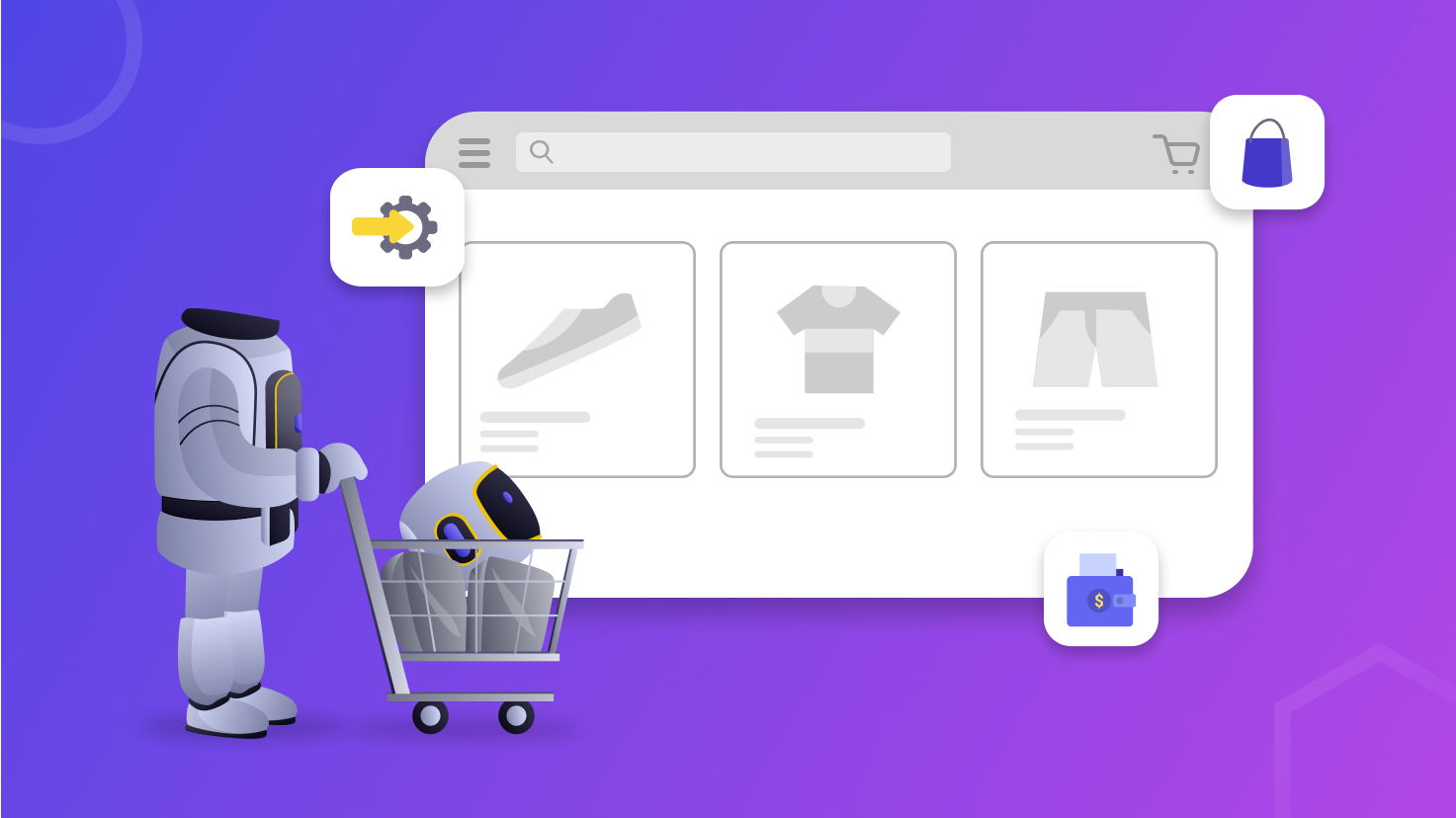
What’s Inside
- What Does Headless Commerce Mean?
- How Do Headless Commerce Solutions Work?
- How Do the Best eCommerce Integrations Benefit Your Online Store?
- Time to integrate your eCommerce platform with headless CMs to elevate your online store to the next level!
- Different Types of Headless eCommerce Platform Integrations Available
- How Headless Commerce Supports Omnichannel Retail?
- Experro Relevant Core Products
- Say goodbye to slow-loading websites and hello to customer satisfaction
- Conclusion
Key Takeaways
- Speed is vital to keep people engaged and interested in what your online store has to offer.
- Slow-loading traditional eCommerce platform websites can lead to a drop in conversion rates, while personalized experiences can increase customer loyalty.
- Integrating with a Content Management System (CMS), such as Headless commerce solutions, enable personalized content, recommendations, and offers, leading to increased sales.
- Headless CMS integrations with eCommerce business logic platforms like Shopify, BigCommerce, and Magento enable unified management of content, products, inventory, and orders.
- Experro's Headless Store Frontend is a core product that offers visually stunning and customizable storefronts optimized for performance and easily integrated with backend systems for business growth.
Did you know?
Headless commerce solution platforms are going to grow tremendously in the market. Don’t believe us? The headless CMS statistics state that too! That means if a website is slow, people are more likely to leave without buying anything.
Another interesting fact is that 44% of digital shoppers are more likely to become repeat customers when they receive a personalized experience. This means tailoring the website to suit each shopper's preferences and needs is vital!
And guess what? Headless Commerce is perfect for personalization! Headless commerce functionality allows developers to seamlessly add new features that cater to each shopper, making their online shopping experience unique and unforgettable.
This means that by integrating Headless Commerce solutions with a Content Management System (CMS), eCommerce businesses can deliver personalized content, recommendations, and offers. This ultimately leads to drive more sales and customer loyalty as a benefit compared to traditional eCommerce.
So, integrating eCommerce with a headless approach is akin to merging the strengths of two worlds into one. It empowers businesses to create lightning-fast eCommerce sites, provide personalized experiences, and ultimately increase sales.
Let’s explore it in detail.
What Does Headless Commerce Mean?
Headless Commerce is commonly used to build online stores or eCommerce sites.
When you view a website, you see both the content and its visual presentation. But with Headless Commerce, things are a bit different.
Imagine a human body! Isn't the head usually attached to the body? But in Headless Commerce, it's like separating the head from the body.
The head represents the part of the website that you see and interact with, like the layout, colors, and buttons. The body means all the important stuff behind the scenes, like managing the inventory, processing payments, and handling orders.
So, Headless Commerce means the "head" and the "body" of a website are now separated.
This separation allows developers to work on the frontend (the head) and the backend (the body) of the website independently. It gives them more flexibility to customize and create unique shopping experiences.
In simple words, “Headless Commerce is like having a website where the design and the functionality are built separately. This makes it easier for developers to make changes and improvements without affecting the whole site. It helps create better online shopping experiences for the users!”
How Do Headless Commerce Solutions Work?
Now that we know what headless commerce means—let's see how it works technically!
Headless Commerce Architecture
Headless commerce is a unique way of setting up an online store, and as per famous eCommerce brands.
There are two main parts in Headless CMS architecture: the front one (where things appear beautiful) and the back part (where all the real stuff happens).
Traditional and headless commerce can easily be recognized based on their architecture. But there's more!
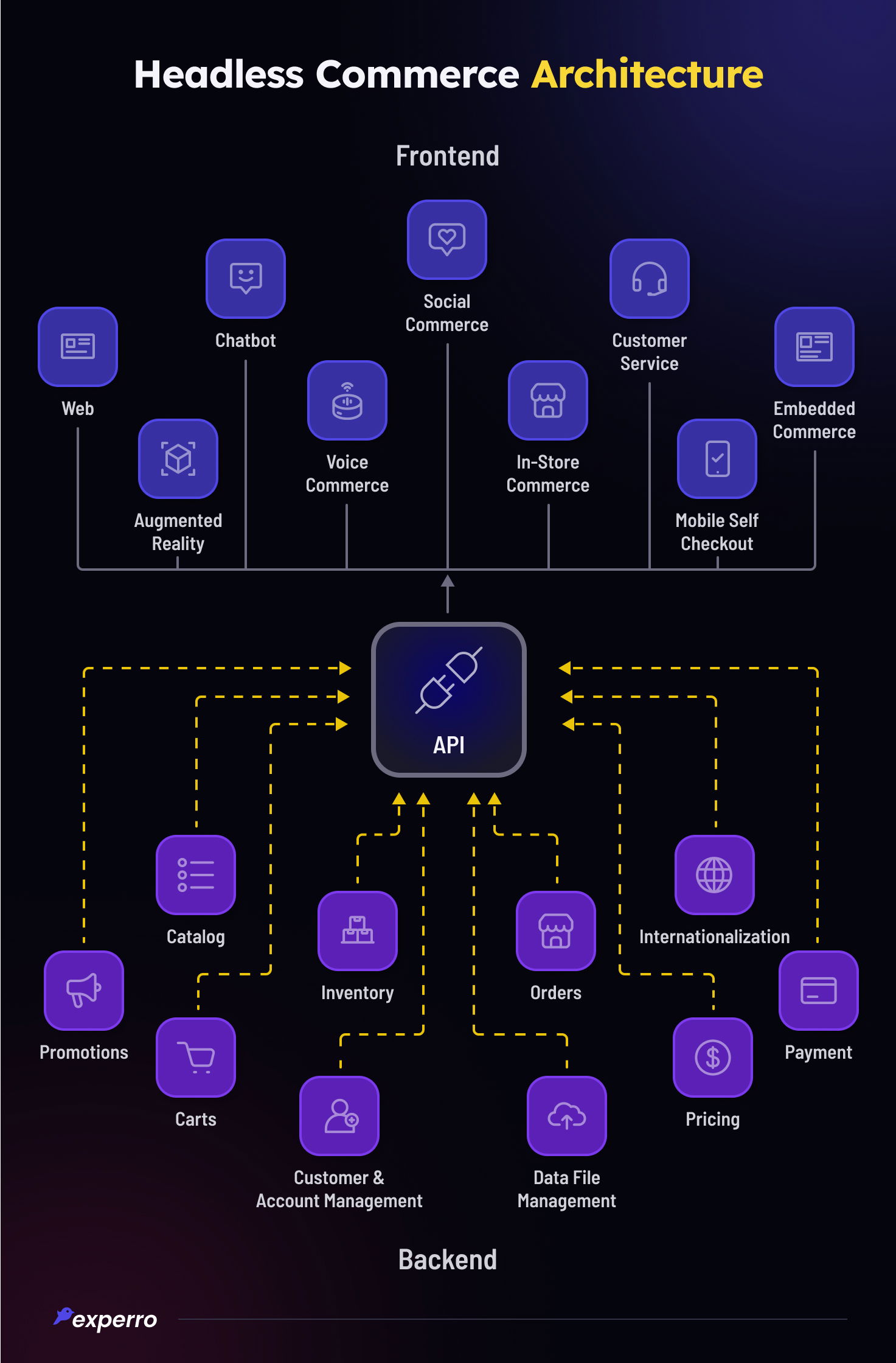
The Role of API in Headless Commerce Platform
Just like with a headless platform, a headless commerce platform is built using something called an API first approach.
Application Programming Interface acts as a medium for different eCommerce systems to communicate with one another. And in headless commerce, there are no limits to who or what it can talk to!
Here's how it goes down:
When you press the button like "Buy Now" on your smartphone, the frontend presentation layer of the headless eCommerce system sends a particular message (called an API request) to the application layer to process your order.
It's like sending a request for the system to do something for you.
Then, the application layer gets back to work and sends another API call to itself to check on the status of your order. It's like asking the system, "Hey, what's up with my order? Is it on the way yet?"
By using these API calls, the different parts of the headless commerce solution can talk to each other and exchange information. It's like they're passing notes to keep everything running smoothly.
These APIs are also used for eCommerce integrations and headless commerce solutions.
BigCommerce's survey reveals that in the coming year, approximately 66% of eCommerce decision-makers expressed their intention to embrace an API driven headless commerce strategy.
eCommerce integrations in a headless CMS refer to the ability to connect your content management system with various eCommerce platforms and tools. This flexibility shows headless CMS working at its best, enabling businesses to build tailored and scalable digital ecosystems.
These integrations enable seamless digital asset management of product catalogs, inventory management integrations, orders, and payment processing within the headless solution.
Indeed, providing a unified and efficient workflow for managing both content and commerce in your online store.
Since the headless approach is not tied to any specific system, it can connect to all sorts of other systems and solutions out there.
How Do the Best eCommerce Integrations Benefit Your Online Store?
When we talk about eCommerce integrations, we mean connecting different tools and systems together to make your online store even better. It's like having a dream team of solutions working together to boost your store's performance.
So, what are the benefits of these headless commerce solutions? Let's find out!
1. eCommerce integrations can supercharge your store's functionality.
- Imagine if your online store could do more than just display products and process orders.
- With integrations, you can add cool features like live chat support, customer reviews, social media sharing, and even personalized product recommendations. It's like giving your store a turbo boost!
2. Next, integration can make your store more efficient.
- By integrating your inventory management system with your online store, you can establish a connection that ensures you have real-time visibility into your product availability.
- They can also automate processes like order fulfillment and shipping, saving you time and effort. It's like having a helpful headless eCommerce platform assistant to take care of the boring stuff!
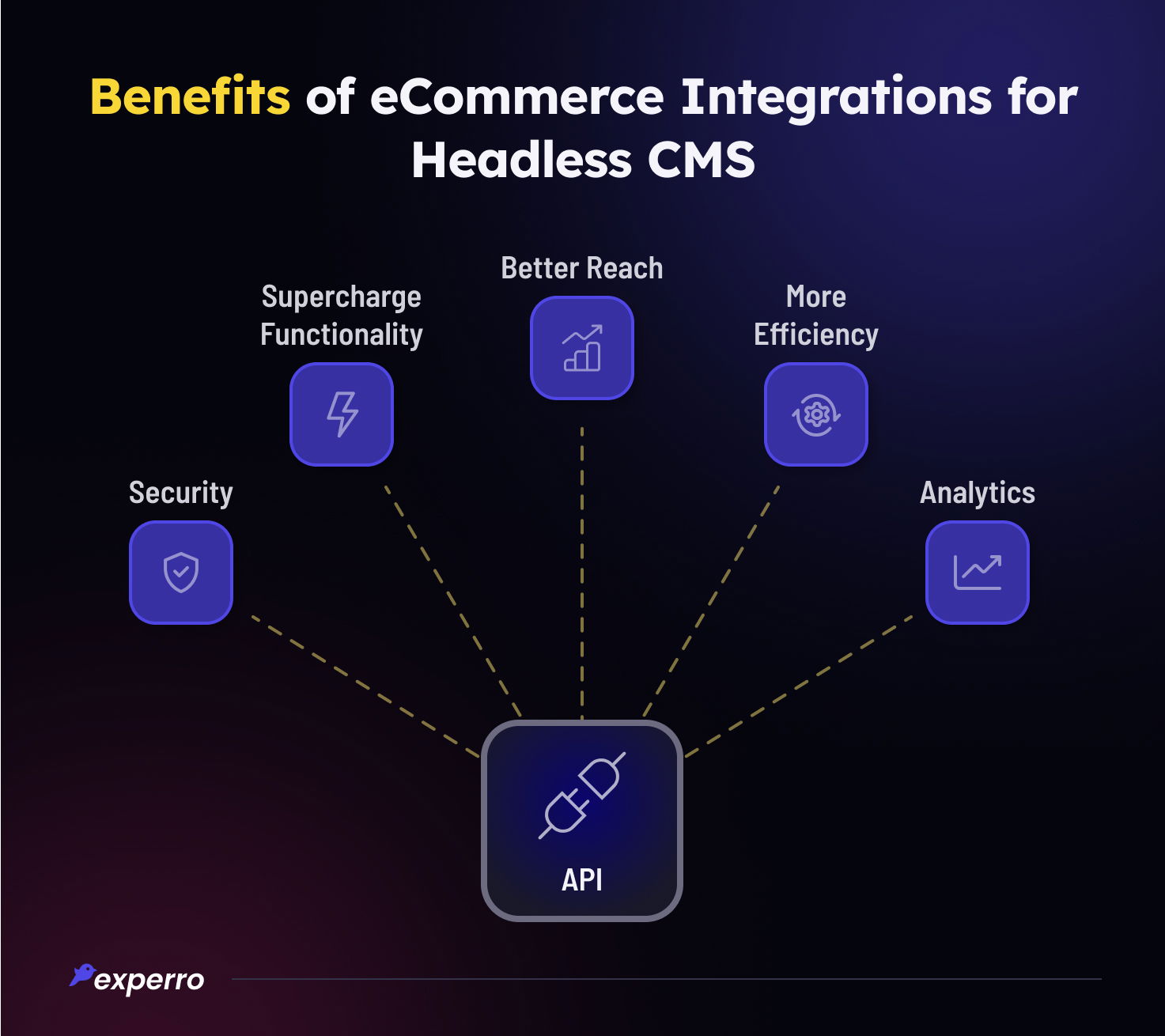
3. Integration can also help you reach more customers.
- For example, you can integrate your store with popular marketplaces like Amazon or eBay, easily which allows you to sell your products to a large audience in comparison to the outdated traditional commerce.
- You can also connect your store with email marketing tools to send targeted promotions and reach out to potential customers. It's like expanding your store's reach and attracting more shoppers!
4. Integration can improve your store's analytics and reporting.
- By connecting your store with analytics tools, you can gather valuable insights about your customers' behavior, popular products, and sales trends.
- This information can help you make smarter online business decisions and optimize your store's performance. It's like having a crystal ball to see what works and what doesn't!
5. Integrations can enhance your store's security and payment options.
- You can integrate with trusted payment gateways to provide secure and convenient payment options for your customers.
- Plus, you can connect with fraud detection systems to protect your store and customers from any shady activities. It's like having a fortress to keep your store safe!
So, the best eCommerce integrations bring a whole bunch of benefits to your online store. They boost functionality, improve efficiency, expand your reach, provide valuable insights, and enhance security.
Different Types of Headless eCommerce Platform Integrations Available
There are different headless eCommerce platforms like Shopify, BigCommerce, and more available.
These integrations allow you to seamlessly connect your content management system with other platforms. Indeed, they enable you to manage your online store's content, products, inventory, and orders in a unified way.
It empowers you to deliver a consistent and engaging shopping experience across multiple channels while leveraging the eCommerce capabilities of these platforms.
Let’s learn about them in brief now!
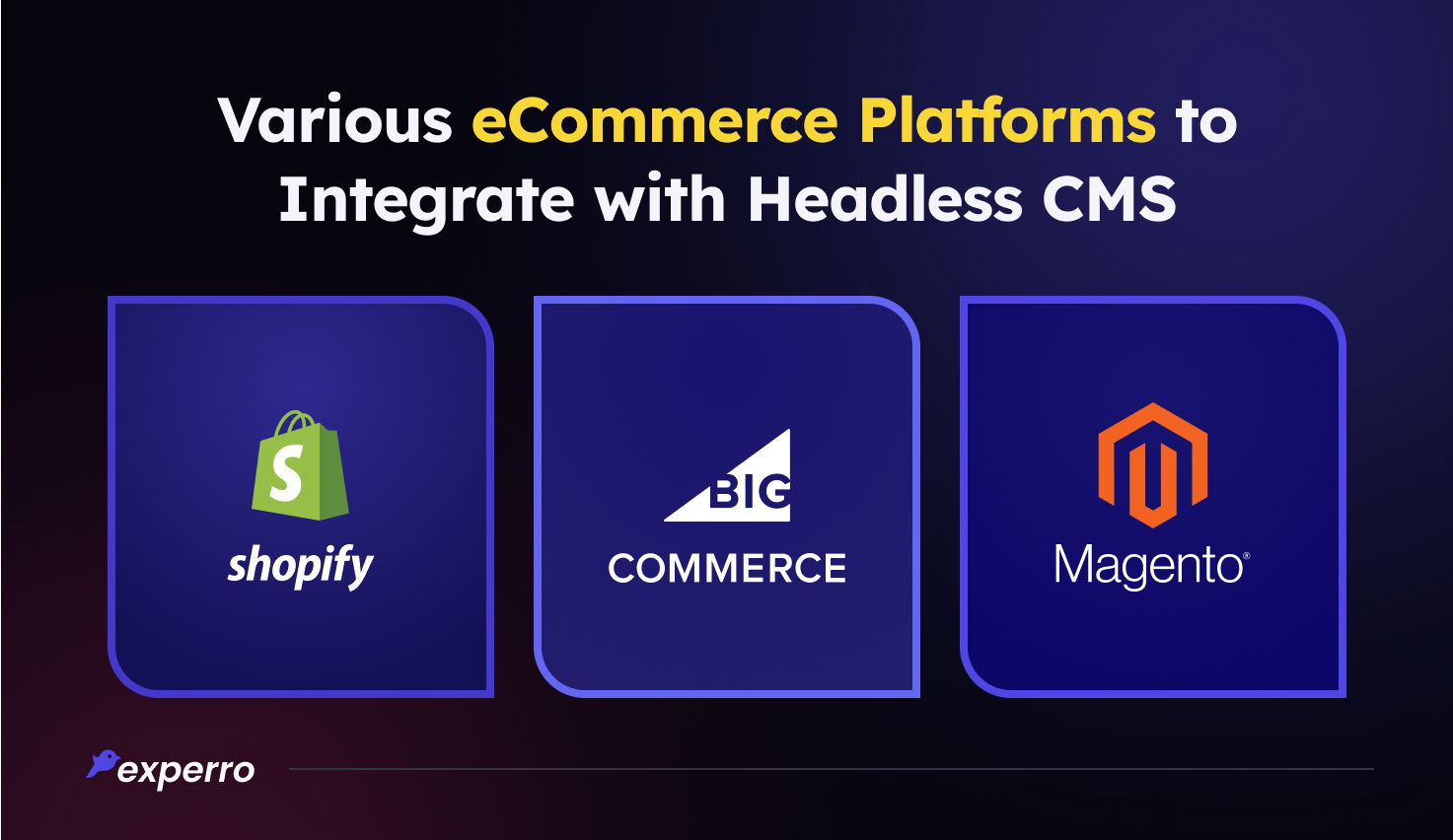
1. Shopify
With the Shopify integration in a headless storefront, you can connect your content management system to the Shopify eCommerce platform.
This integration enables you to manage your product catalogs, inventory, orders, and customer data from within your headless eCommerce CMS.
It allows you to leverage the robust eCommerce features of Shopify while maintaining control over your content and presentation layer.
2. BigCommerce
By integrating BigCommerce in headless commerce solutions, you can seamlessly synchronize your content management system with the BigCommerce eCommerce platform.
This integration helps manage your product listings, inventory, pricing, and orders from your headless CMS itself. You can deliver personalized content and consistent shopping experience while leveraging the eCommerce capabilities of BigCommerce.
3. Magento
There are a number of best headless eCommerce platforms though integrating Magento with a headless CMS enables you to connect your content management system to this popular eCommerce platform.
By doing so, you can manage your product catalogs, pricing, inventory, and orders directly from your headless CMS. This integration allows you to deliver rich and engaging content alongside powerful eCommerce functionalities provided by Magento’s commerce engine.
How Headless Commerce Supports Omnichannel Retail?
Apart from omnichannel content distribution, a headless CMS also supports seamless shopping experience across multiple channels like online stores, progressive web apps, mobile apps, social media platforms, and even physical stores. And that's where headless commerce comes in to save the day!
With headless commerce platforms like Experro Commerce, Adobe Commerce, Salesforce commerce cloud, you create seamless digital experiences.
You get a fully customized eCommerce website that has the flexibility to deliver consistent and engaging experiences on every channel.
eCommerce store helps you at every step of the customer journey.
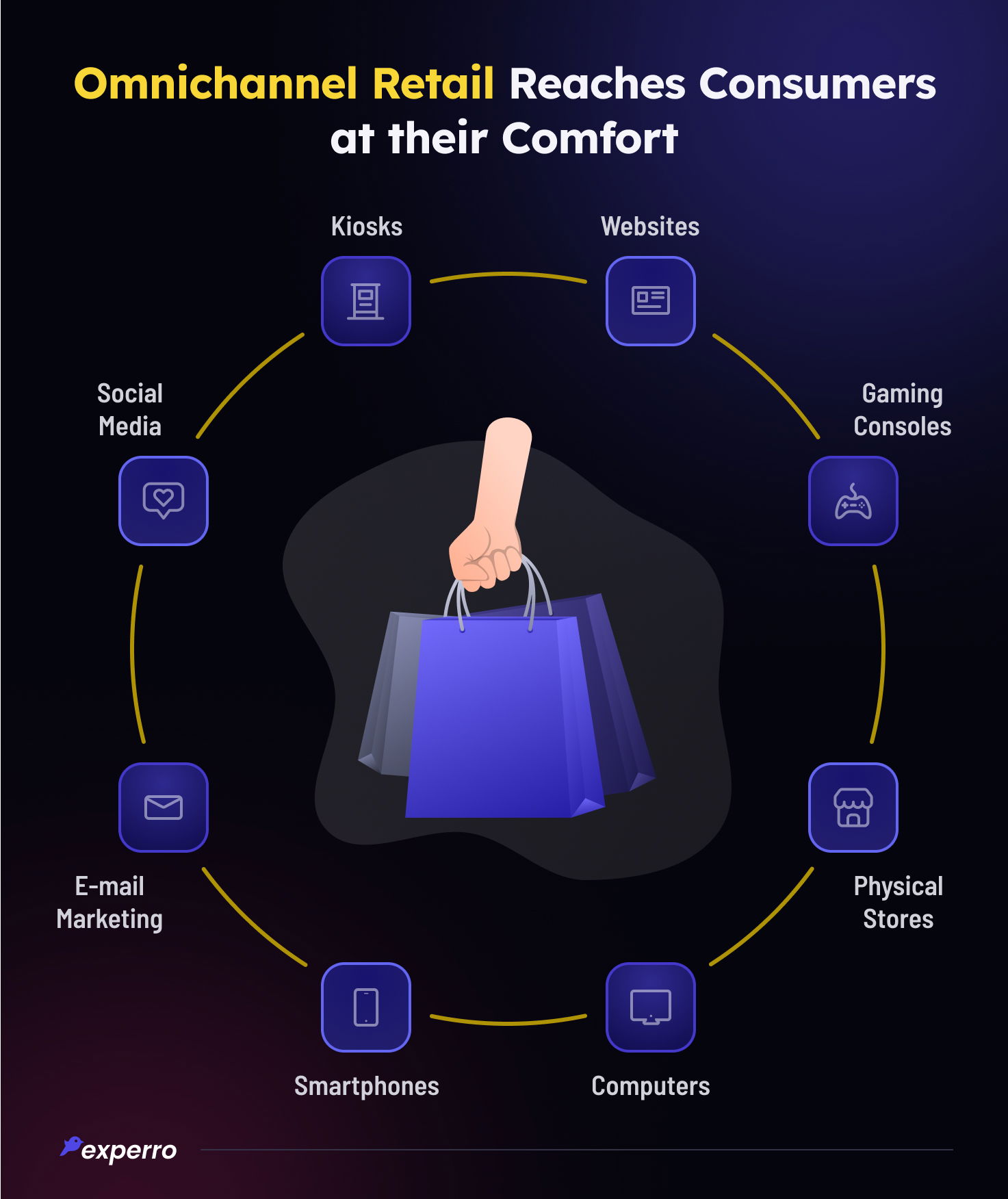
With a headless eCommerce store, you can design and optimize the frontend technology independently for each channel.
So, whether your customers are browsing on a desktop, smartphone, or tablet, they'll have a seamless and tailored experience. It's like having a custom-fit suit for every device!
With headless commerce platforms, you can centralize and streamline stuff like inventory management, order processing, and payment handling operations across all channels.
Now, here's where the real magic happens:
Headless commerce allows you to easily integrate with various systems and platforms. You can connect with customer relationship management (CRM) tools, marketing automation software, and even third-party marketplaces.
This way, customers can start their shopping journey on one channel and seamlessly continue it on another without any disruptions. It's like teleporting from one place to another while keeping the shopping excitement intact!
Thus, headless commerce is the ultimate champion of omnichannel retail!
Experro Relevant Core Products
Experro offers amazing core products to solve DXP and multiple touchpoints issues like its "Headless store frontend" product. Let's dive into what this product is all about!
The Headless Store Frontend is like the face of your online store. It's the part that your customers see and interact with when they visit your website, progressive web app, or mobile app. But what makes it special is that it's built using a headless architecture.
With Experro's Headless Store Frontend, you can create a visually stunning and engaging shopping experience for your customers. It even offers custom solutions in a way.
So, you have full control over the design, layout, and user interface, ensuring that it perfectly represents your brand and captures your customers' attention.
But the real power lies in the "headless" part. Since the frontend is independent of the backend eCommerce functionality, you can easily integrate it with different backend systems, like headless solutions or an eCommerce platform.
This means you can combine the best tools for managing your content and handling your store's operations without any restrictions.
Imagine having a beautifully designed store that seamlessly integrates with your inventory management system, order processing system, and even third-party tools like customer analytics or marketing automation.
And guess what Experro eCommerce integrations does exactly this!
Oh, and did we mention that Experro's Headless Store Frontend is built with performance in mind?
It's optimized for speed, ensuring that your store loads quickly and provides a smooth and enjoyable shopping experience for your customers. Nobody likes waiting for a slow-loading website, right?
And Experro exactly takes care of that for you!
Conclusion
In today's digital world, having a great eCommerce website is all about having awesome headless commerce solutions. It's not just about selling stuff but also about connecting with your customers in a meaningful way.
That means providing interesting and helpful information that keeps them engaged and wanting to come back for more. And for this, you need to stay active on all channels possible, which requires different eCommerce integration.
So, focus on creating content with the right headless commerce platforms and eCommerce functionality in contrast to traditional web platforms that spark conversations and make your website stand out from the rest!
FAQs


Ekta Ganwani
09 July 2024With a sharp knowledge of SEO and SERP, Ekta's research is her strength. She is a meticulous researcher with an eagle eye for finding errors and ensuring on-page content is top-notch. When not working, Ekta can be found binging the latest Netflix series or meditating to find her inner zen.